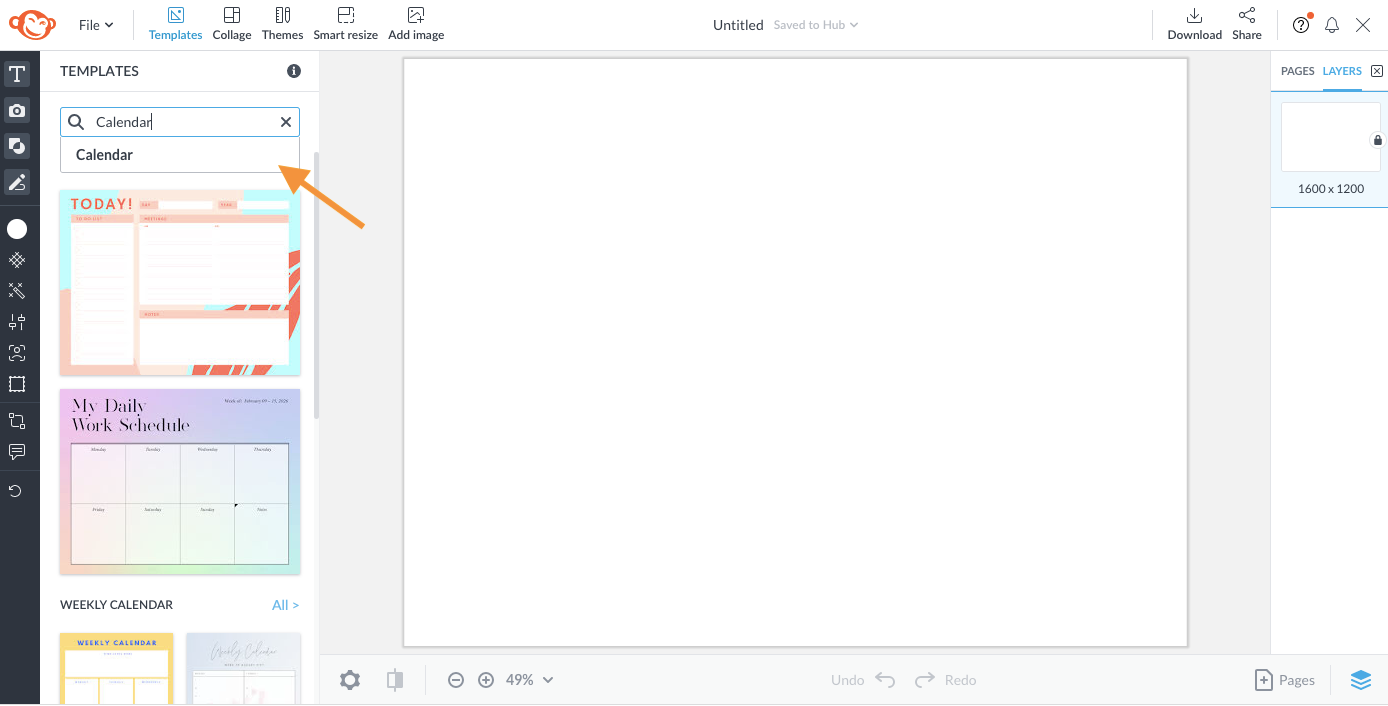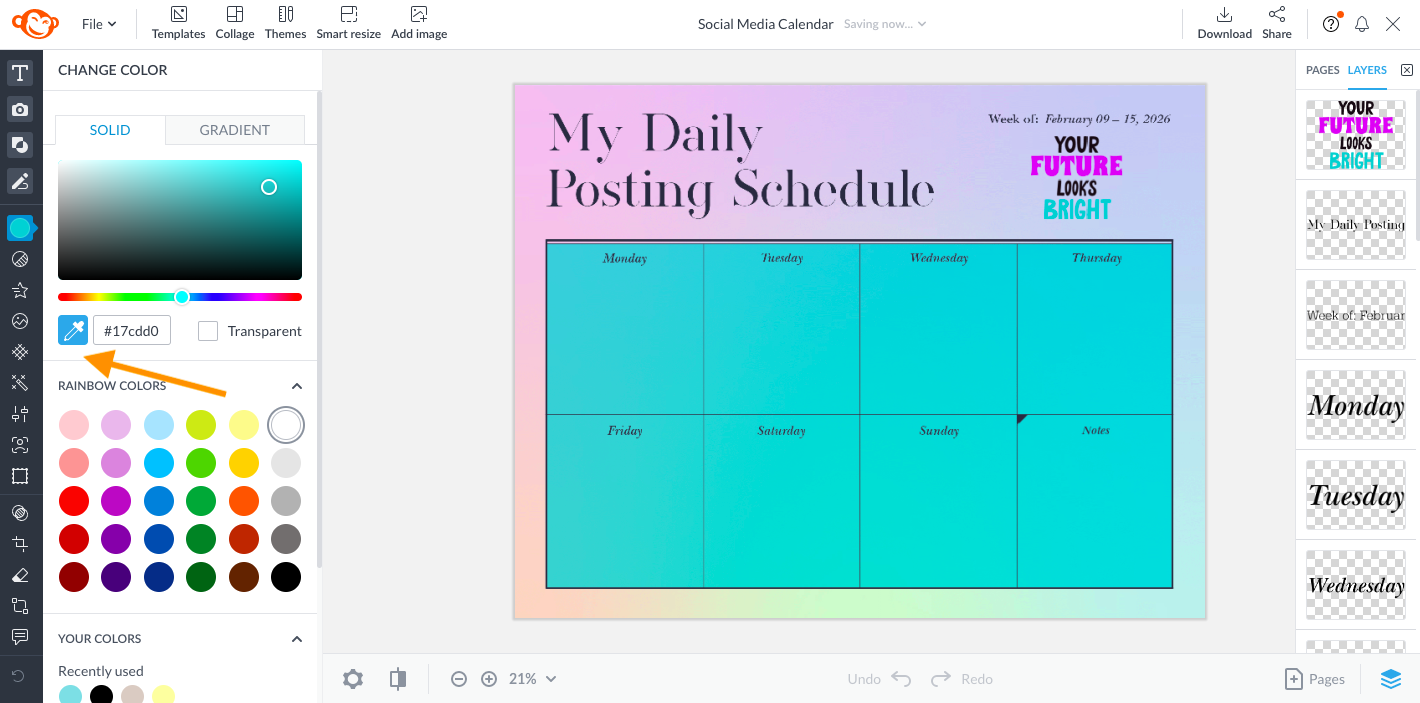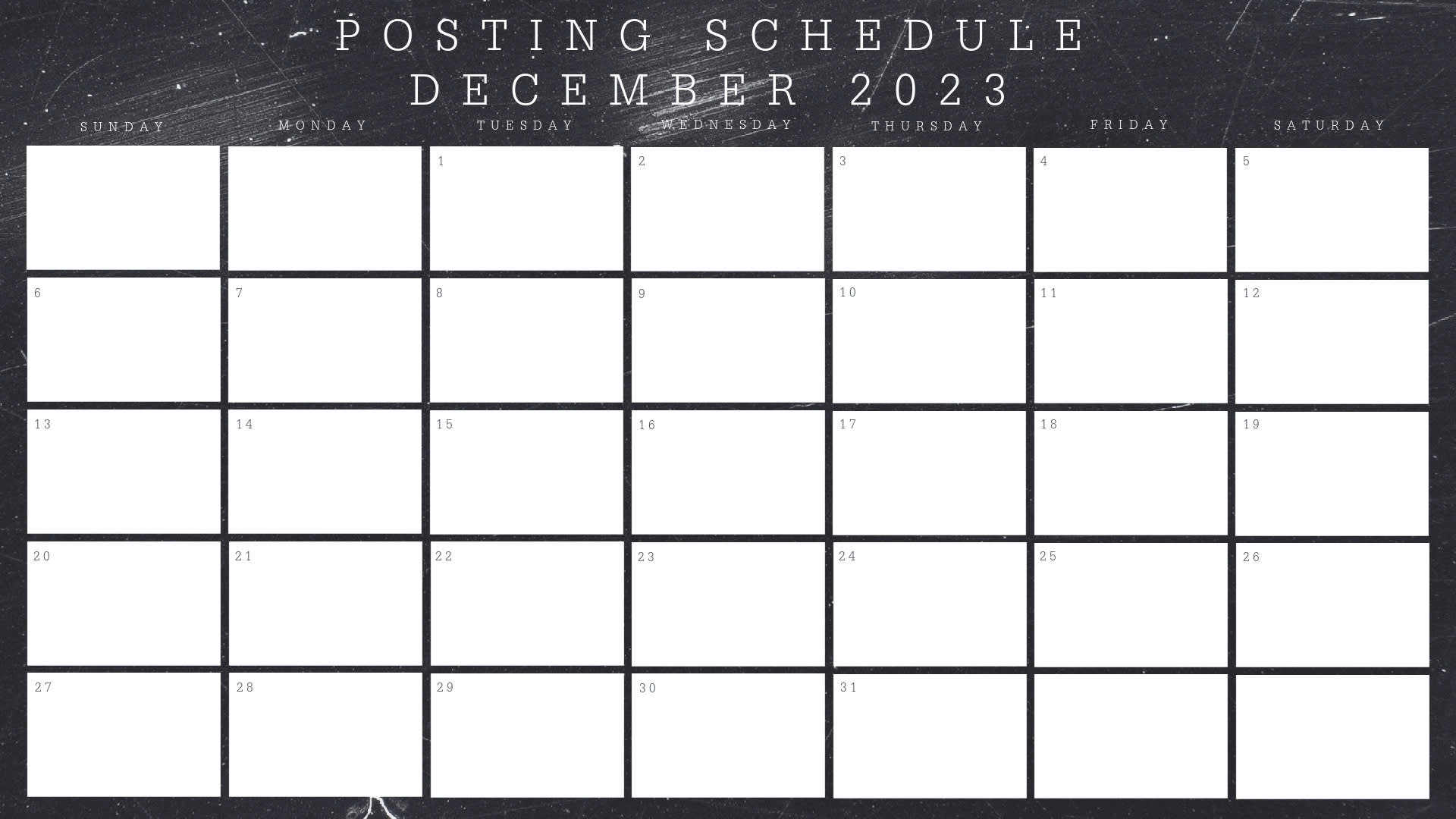
There's no quicker route to mental chaos than juggling your content creation ideas for Facebook, Instagram, Twitter, YouTube, and TikTok—all without a social media calendar. To that we say, stress, begone!
No matter if you like to operate ~in the flow~ or prefer down-to-the-minute structure, social media calendars can suit your creative style and process—all in one place. Put down the sticky notes, phone note ramblings, and jotted down snippets.
You deserve organization. And the 4.74 billion social media users of the world want to see you at your best.
Today, we're jumping into all things social media content calendars, content creation strategies and tips, and how to design your own social media calendar in PicMonkey. You ready?
What is a social media calendar?

Love this look? Make it your own in PicMonkey!
Before we get into the design aspect, it probably helps to know what, exactly, social media calendars—content calendars—even are. Simply put, social media calendars are comprehensive overviews of one's upcoming social media posts, sorted by date, day, type, and time. In short, social calendars help organize one’s overall social media strategy.
You can make your social calendar as detailed or general as you like. Different from a generalized to-do list, content calendars are specific to your upcoming social media posts.
Similar to to-do lists, however, you can use daily, weekly, monthly, or yearly calendars to organize your life. Perhaps you tag-team with a nifty spreadsheet as a place to map out your ideas. When you get clearer about what to post and when, you can segment your spreadsheet in a social media calendar from PicMonkey!
No matter what stage of content creation you're in, having a content calendar that's both functional and fashionable holds multiple benefits.
Top 5 social media calendar benefits
Having a plan is a quick and easy way to achieve your short and long-term goals. We’ve outlined in more detail below some of the main reasons why using a calendar to make a social media posting schedule is beneficial.
1. Saves time
Having all of your ideas in one place not only keeps you organized, but it lets you mass-produce content in advance, prep for what's upcoming, and save less time actually posting.
Plus, with the nifty features on social media these days, you can schedule your posts in advance so you don't have to drop your life to post.
2. Reduces mistakes
Social media calendars help you know that you haven't duplicated content (another time-saver!). Beyond content frequency, we're all about content quality. Quality content comes from original and fresh ideas, not replicated posts.
3. Fosters collaboration
If you work with a team, social media calendars are a great way to encourage and facilitate collaboration. By using a shared document or platform that you and your colleagues can access, you can delegate posts for a more efficient workflow. This can result in a higher quality of work, as everyone can share ideas and comment on ideas from others.
If you're a rockin' solopreneur or just need some guidance for juggling your life, calendars simply help you get your thoughts on paper so you can free up your time for kids, writing, or whatever other duties you have.
We want you to free up that mental real estate, folks! Not just for work, but for a better life.
4. Refines your craft
Making content calendars directly improves your social media strategy. They might highlight for you where you or your team could improve. Make improvements in advance and save yourself from stressful last-minute work.
5. Stimulates creativity
Social media strategies are innately creative. So is crafting your own calendar. It's easy to lose track of the bigger picture when you're posting one post at a time.
With any effective marketing, aim to tell a story. If you don't know what that story is, ask yourself:
What's your brand message?
Who's your target audience?
How can you authentically express who you are and what you offer?
How can your posts relate to each other naturally and cohesively?
There are infinite ways to craft your strategy, so you might want to identify your timeline for achieving specific milestones. That may provide context for what you post and when.
Beyond your creative thought process, design is innately creative! Customize with brand colors, brand fonts, background textures, effects, and more—all right here with PicMonkey.
Speaking of PicMonkey...
Make rockin' social calendars fast with PicMonkey

Love this look? Make it your own in PicMonkey!
Before we continue chatting about your social media strategy, let's talk design. There are two different ways you can design inside the tool: blank canvases and templates.
There are always advantages to both routes, but we have a hunch you'll prefer templates in this instance. (Unless you prefer making grids and lines like a boss, in which case, get after it.)
To get to the templates, simply click File > Create new > Templates. Type "Calendar" into the search bar. You'll notice Daily, Weekly, and Monthly Calendar categories pop up right away. Select your favorite and customize! Easy as pie.

Pro Tip: Know that you can always customize any type of calendar or checklist template to suit your social media needs.
Some quick ideas for customization? You bet!
1. Personalize text
A few tips for text. PicMonkey's got hundreds of font options to choose from in order to craft a legible and polished look. Brand fonts are always encouraged, especially if you're working with a team.
If you're the only one who will be seeing the calendar, personal aesthetic is up to you, so long as you can read it. To find your font faves, simply click Text > Add text (or simply double-click the designated text box) and scroll the font options.

Know that the templates will already have fonts designated for you, so switching them up is totally up to you, and dependent on how many details you include.
Pro Tip: If you don't want to type out your schedule, know you can also print them out. Before you download, account for bleed marks by clicking the Settings (gear) icon on the bottom toolbar. Toggle on Show bleed marks.

2. Customize background
Ah, backgrounds! Again, whether you're using a template or blank canvas, backgrounds are the eye-grabbing design aspect that'll motivate you throughout your days. You have multiple options for background customization:
Images
Textures
Effects
Solid colors
Gradient colors
Know that you can layer multiple aspects on top of each other, so long as it doesn't cause a design catastrophe. Layering an effect over a background texture is nice! Layering two busy textures? Not so nice. Avoid the eye sore. Future you says thanks.
You'll find the images in the Photos & Video tab, effects in the Effects tab, textures in the Textures tab, and colors in the Background color circle tab. All of these options live on the lefthand menu for the taking.
3. Customize graphics
Graphics are a sweet way to customize your calendars fit for your field. You can also insert graphics that motivate, inspire, and encourage you each step of the way. Our suggestions?
In the Graphics tab, you'll notice tons of categories that are available to you. In the Whimsy section, for example, we snagged the Your Future Looks Bright sticker. Once you select it, simply drag it to the canvas and adjust size accordingly.

Plus! You can change the graphics colors to suit your vibe by click the Change colors option on the lefthand side.
Pro Tip: To customize one design aspect with the color of another design aspect, be sure to optimize our Eyedropper Tool! Highlight the aspect on the canvas you want to change, then select Text color or Background color (depending on which aspect you highlight). Click the Eyedropper Tool, drag it to the color you want, then release to set!

Insert Joey Tribbiani's voice here: Could it be any easier?
7 best practices while using social media calendars

Love this look? Make it your own in PicMonkey!
Alright, alright, alright. Social media calendar benefits? Check. Design? Check. Time to create a solid social media strategy with the following best practices.
1. Analyze your social networks and published content
Take inventory. Ask yourself:
What do I have published already?
Are there common threads?
What do I need more of?
Where is my highest engagement?
Where is my lowest engagement?
What story am I telling?
If you plan on changing your aesthetic, this is also the time to decide what old posts you plan on keeping on your social media accounts and what you wish to remove in order to give you space for your new brand. It's okay to edit!
2. Examine content types
What content types do you prefer? There are:
Blogs
Single-image posts
A successful social media strategy incorporates all of these content types at some point. Be clear about when to use which types of content. Of course, visuals and videos capture an audience faster and longer.
Depending on the social media channel, you'll want short and sweet reels and videos for higher engagement.
You can also promote products, share quotes, or offer tips. Let your goals inform the type of content you use.
It’s also important to keep your target audience in mind and to be aware of whether members of this audience are particularly active on one social media platform versus another.
3. Select your social channels
Now that you know what content you’ll share, you can establish which platforms to post on. Note that you can cross-link accounts on different channels to ensure your posts upload all at once.
Efficient, eh? Images and videos are great for Instagram, whereas Twitter works well for short quotes and tips. You can also select some platforms to link to longer blog posts that you publish on your website.
For extra organization, on your spreadsheet, document which platforms you posted on, as well as the dates you posted. You can also include what type of content it is, as well as any copy that will be included in the post. Feel free to color-code or find a system that works well for you.
4. Monitor trends
Although social media calendars help you plan well in advance, it’s important to stay flexible, as popular trending content will always take top priority. Stay relevant, boost engagement. Simple as that.
5. Establish content stages
If you want to get a bit more granular, draft up a breakdown of step by step processes involved in each post. What does each post require? Keep this on the back-end so as not to overcrowd the content calendar itself.
Consider:
Who's writing your content posts?
How much editing is needed?
How long will it take to draft?
Who's responsible for associated images?
Where do those images come from?
Once you have a general structure for your content creation, you can accurately assess how much time and energy future posts take to expedite your processes.
6. Craft a publishing schedule
Publishing schedules can help you post on all platforms equally and efficiently without overwhelm. Here are a few things to consider.
The number of social platforms you have
Which accounts are cross-linkable
What times of the day / week are best to post
Asking yourself the hard questions now will grant you the success later (slash, also now).
7. Take advantage of holidays and seasonal happenings
National, global, and seasonal, and corporate holiday events happen throughout the year. Don't miss out on opportunities to highlight those trending topics, too. PicMonkey's chock-full of customizable holiday templates, sales templates, and generalized small business marketing materials galore.
Consider these seasonal holidays marketing freebies, where inspo is rampant and clever copy is abundant. Plus, you'll stay relevant as ever with holiday themes, discounts, and giveaways.
Social media calendars are important and effective tools for planning content that is engaging for your audience and helps you create assets for social media marketing.
By making your own social media calendars, you strengthen your overall brand strategy, messaging, and execution. You'll save time, limit mistakes, stay creative and relevant, and attract exactly who needs to see your content.
In the end, the benefits that you will gain are well worth the time and effort invested. Your turn! Hop into PicMonkey and give your content planning a whirl. See ya on the other side!
